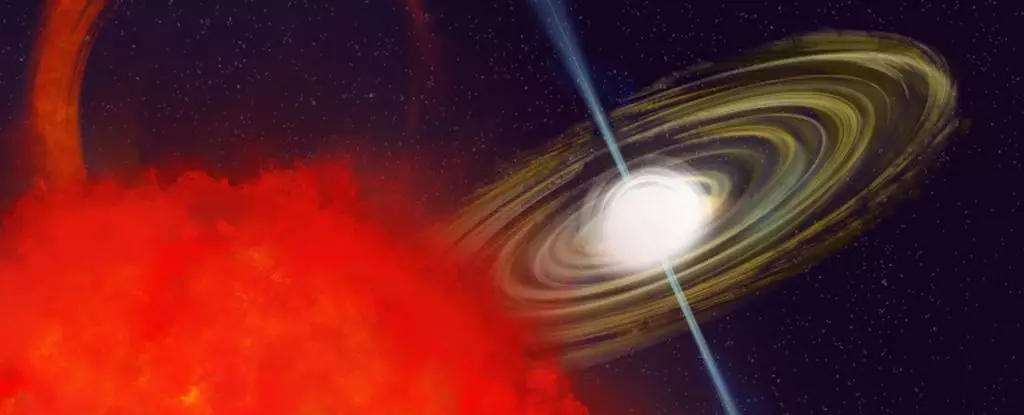In the vast tapestry of our galaxy, the Milky Way, astronomers continue to uncover phenomena that stretch the boundaries of our understanding. Among these cosmic surprises, the discovery of CHIME J1634+44 stands out as a beacon of intrigue and potential revelation. Unlike typical celestial objects, this enigmatic entity exhibits a set of behaviors that defy current astrophysical models, compelling scientists to reconsider the diversity and complexity of compact stars. Its exceptional polarization, peculiar periodicities, and the mysterious acceleration of its spin place it in a league of its own—a true astrophysical unicorn that challenges the notion of what we thought was possible in our universe.
Decoding the Mysteries of Long-Period Transients
Long-Period Transients (LPTs) are a rare breed of cosmic phenomena characterized by their persistent yet unpredictable radio wave emissions. Historically, only a handful of these objects have been identified, each offering a glimpse into the extreme environments surrounding dense stellar remnants. However, CHIME J1634+44 breaks the mold. Located thousands of light-years away, this object exhibits a set of unusual properties that demand closer scrutiny.
One of the most striking features is its extremely high level of polarization—more polarized than any other LPT ever observed. This hints at a complex magnetic environment within or around the object, possibly involving intricate magnetic field configurations or atypical emission mechanisms. Furthermore, unlike most celestial bodies that gradually slow down over time due to energy loss, CHIME J1634+44 appears to be speeding up. Its periodic radio pulses are decreasing in duration, indicating an increasing spin rate. This counterintuitive behavior suggests an active transfer of angular momentum, likely through accretion processes, which are more commonly associated with black holes or neutron stars possessing binary companions.
The puzzle deepens with the detection of not just one, but two related periods—approximately 14 minutes (841 seconds) and a longer one of about 70 minutes (4206 seconds). The secondary period appears to be an exact multiple of the primary, hinting at orbital dynamics involving a companion object. If true, this could position CHIME J1634+44 as part of a binary system, with material flow or orbital interactions influencing its observable properties.
Competing Interpretations: Neutron Star or White Dwarf?
The central question surrounding CHIME J1634+44 pertains to the identity of its compact core: is it a neutron star or a white dwarf? Both are the remnants of stellar evolution after massive stars exhaust their fuel, but their physical characteristics and behaviors differ markedly.
Neutron stars are extraordinarily dense—packing more than the Sun’s mass into a sphere only about 20 kilometers in diameter. They are known for their intense magnetic fields, rapid spins, and, in some cases, acting as pulsars that emit beams of electromagnetic radiation periodically. A neutron star scenario could explain the high polarization and rapid spin-up if the object is accreting matter from a close companion. This inflow of material can transfer angular momentum, causing the star to spin faster, and potentially produce the polarization patterns observed.
On the other hand, some data suggests that CHIME J1634+44 might be a white dwarf—less dense but still compact, with a radius comparable to Earth. A faint ultraviolet source aligned with its position hints at a white dwarf, estimated to be about 78% of the Sun’s mass and with an enormous temperature range. White dwarf pulsars are exceedingly rare, but their existence could explain the long-period emissions and the unique polarization signals. A white dwarf accreting material can also spin up, and theoretical models propose the possibility of a white dwarf pulsar—an elusive entity that blurs the lines between well-understood stellar remnants.
The debate remains open, as both hypotheses could fit some of the observed data. There is a pressing need for further observations, particularly to detect signatures that distinguish between the two. For example, pulsar timing methods or more detailed ultraviolet and X-ray measurements could ultimately reveal the true nature of CHIME J1634+44.
Implications and the Road Ahead
If CHIME J1634+44 turns out to be a neutron star, it would represent an extraordinary case of a rapidly spinning, highly polarized, binary-influenced pulsar exhibiting unusual periodicities and manifesting characteristics unlike any known to astronomy. It could necessitate revisions to models of pulsar evolution and magnetospheric physics, especially around how accretion can influence spin dynamics and polarization.
Alternatively, if it is a white dwarf—a rarer class of objects—this discovery could open an entirely new chapter in stellar astrophysics. White dwarf pulsars would challenge existing theories on magnetic field generation, spin regulation, and the lifecycle of stellar remnants. They could also serve as laboratories for exploring extreme physics in a different regime than neutron stars.
In either case, CHIME J1634+44 exemplifies how our universe continually surprises us. Its peculiar behavior and the clues it offers could rewrite parts of stellar evolution lore or lead to the identification of a novel class of astrophysical objects. The scientific community’s task now is to gather more data, refine models, and embrace the possibility that this cosmic “unicorn” might be a gateway to understanding phenomena that are currently beyond our reach.

